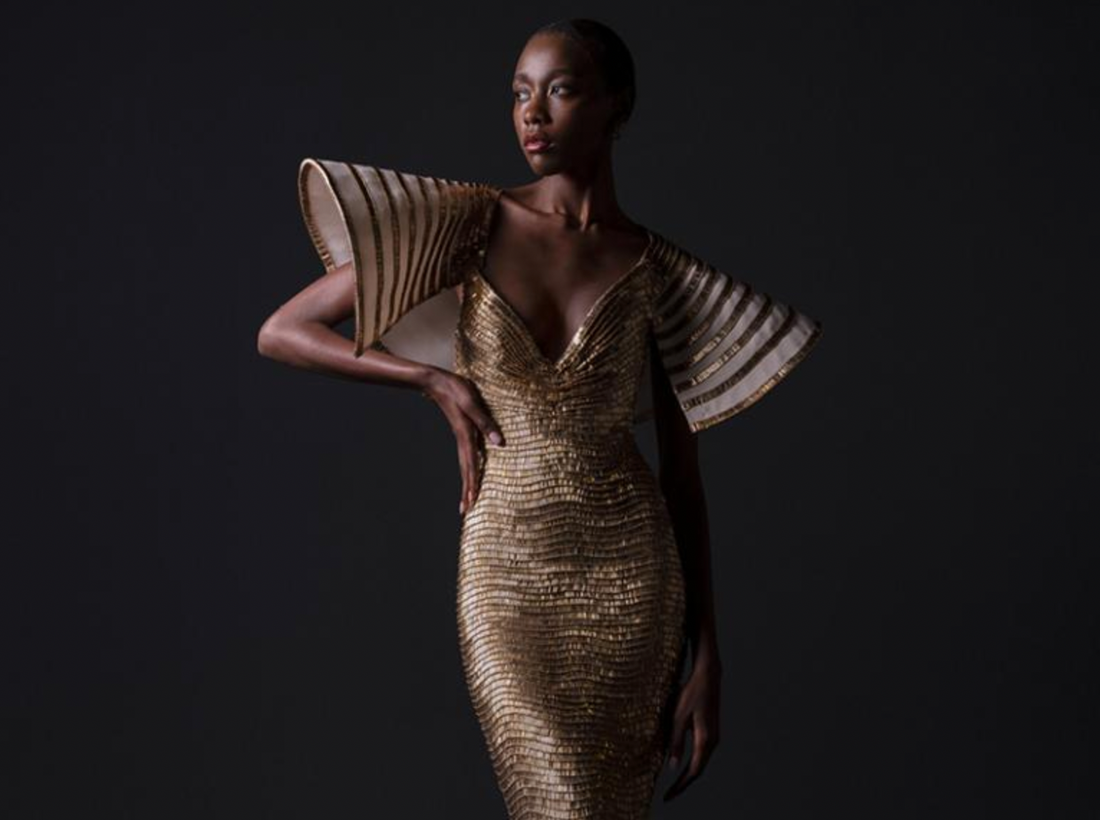
Egyptomania: Fashion’s Conflicted Obsession
Egyptian art has long served, and continues to serve, as a primary inspiration for fashion designers, solidifying the legacy of Egyptomania—the influence of the art of ancient Egypt. This exhibition, on view in the CMA’s textile and Egyptian galleries, brings together around 50 objects that explore the influence of Egyptomania in fashion by juxtaposing contemporary fashion and jewelry loaned from around the world with fine and decorative artworks from The Cleveland Museum of Art collection. Egyptomania: Fashion’s Conflicted Obsession examines designers’ interpretations of themes, such as Egyptian dress, funerary process, and religion, that shape our contemporary perceptions of ancient Egyptian culture.

Scalia, Fall 2018, 2018. Maison Yeya (Emirati, est. 2006). Yasmine Yeya (Egyptian, b. 1981). Hand-dyed tulle and hand-embroidered faux feathers and crystals. Courtesy of Maison Yeya, Les Marionnettes Couture Collection.
The complex history of European imperialism in Egypt, which dates back to the ages of the Greeks and Romans, has made Egyptomania in European and American art controversial. After a lull in diplomatic European interactions with Egypt from the Middle Ages to the 18th century, the 1798 invasion of the country by the French army, led by Napoleon Bonaparte, reinvigorated European and American interest in ancient Egyptian art and culture.

Egypt and Nubia, Volume II: Pyramids of Geezeh, 1848. Louis Haghe (British, 1806–1885). Color lithograph; 43.8 x 60.2 cm. The Cleveland Museum of Art, Bequest of John Bonebrake, 2012.155
European archeological expeditions throughout the 19th and 20th centuries sent back massive amounts of Egyptian art to European and American museums, rousing a recurring interest in its forms in decorative arts, architecture, and fashion. After the 1922 discovery of King Tutankhamun’s tomb, fashion’s leading minds, from Paul Poiret to accessory enterprises like Cartier, fiercely embraced ancient Egyptian art as inspiration, making Egyptomania a staple design element. Since then, interest in ancient Egyptian culture has expanded rapidly across media, particularly platforms adjacent to the fashion industry. The exhibition also displays videos of runway shows that demonstrate fashion’s continued discourse with Egyptian art.

Scarab Brooch, 1924. Cartier (French, est. 1847). Gold, platinum, blue Egyptian faience, diamonds, emerald, smoky quartz (scarab), enamel; 5 x 13 x 2 cm. Cartier Collection. Photo: Vincent Wulveryck, Collection Cartier. © Cartier.
Numerous questions raised by the intersection between Egyptomania and fashion in today’s social climate are also examined in the exhibition. Dialogues about cultural appropriation, ancient Egypt’s place in African history, and Black empowerment continue to bubble to the surface, critiquing fashion’s conflicted obsession with Egyptian art.
Egyptomania: Fashion’s Conflicted Obsession is on show at The Cleveland Museum of Art until 28 January 2024.
Find and more and plan your visit:
www.clevelandart.org/exhibitions/egyptomania-fashions-conflicted-obsession

Scalia, Fall 2018, 2018. Maison Yeya (Emirati, est. 2006). Yasmine Yeya (Egyptian, b. 1981). Hand-dyed tulle and hand-embroidered faux feathers and crystals. Courtesy of Maison Yeya, Les Marionnettes Couture Collection.
The complex history of European imperialism in Egypt, which dates back to the ages of the Greeks and Romans, has made Egyptomania in European and American art controversial. After a lull in diplomatic European interactions with Egypt from the Middle Ages to the 18th century, the 1798 invasion of the country by the French army, led by Napoleon Bonaparte, reinvigorated European and American interest in ancient Egyptian art and culture.

Egypt and Nubia, Volume II: Pyramids of Geezeh, 1848. Louis Haghe (British, 1806–1885). Color lithograph; 43.8 x 60.2 cm. The Cleveland Museum of Art, Bequest of John Bonebrake, 2012.155
European archeological expeditions throughout the 19th and 20th centuries sent back massive amounts of Egyptian art to European and American museums, rousing a recurring interest in its forms in decorative arts, architecture, and fashion. After the 1922 discovery of King Tutankhamun’s tomb, fashion’s leading minds, from Paul Poiret to accessory enterprises like Cartier, fiercely embraced ancient Egyptian art as inspiration, making Egyptomania a staple design element. Since then, interest in ancient Egyptian culture has expanded rapidly across media, particularly platforms adjacent to the fashion industry. The exhibition also displays videos of runway shows that demonstrate fashion’s continued discourse with Egyptian art.

Scarab Brooch, 1924. Cartier (French, est. 1847). Gold, platinum, blue Egyptian faience, diamonds, emerald, smoky quartz (scarab), enamel; 5 x 13 x 2 cm. Cartier Collection. Photo: Vincent Wulveryck, Collection Cartier. © Cartier.
Numerous questions raised by the intersection between Egyptomania and fashion in today’s social climate are also examined in the exhibition. Dialogues about cultural appropriation, ancient Egypt’s place in African history, and Black empowerment continue to bubble to the surface, critiquing fashion’s conflicted obsession with Egyptian art.
Egyptomania: Fashion’s Conflicted Obsession is on show at The Cleveland Museum of Art until 28 January 2024.
Find and more and plan your visit:
www.clevelandart.org/exhibitions/egyptomania-fashions-conflicted-obsession
